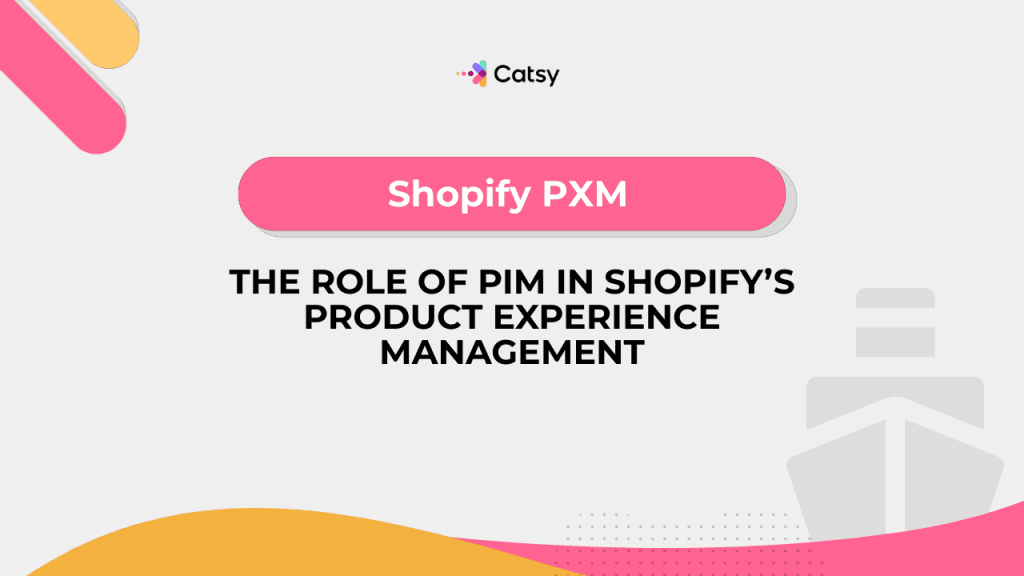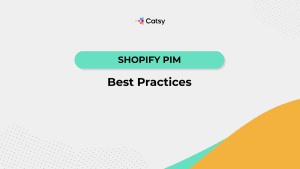The Role of PIM in Shopify’s Product Experience Management
Discover how PIM drives Shopify’s product experience management (PXM). Learn how Catsy empowers merchants to create consistent, personalized product content that converts.

Table of Contents
- Introduction
- Understanding Product Experience Management (PXM)
- The Strategic Role of PIM in PXM
- How PIM Enhances the Shopify Product Journey
- Shopify PXM in Action: Real Use Cases
- How Catsy Helps Shopify Merchants Master PXM
- PIM vs PXM vs DAM: Clarifying the Waters
- Setting a Course for the Future: Why PIM is a Must-Have for PXM
- Conclusion
What You Will Learn
- What Product Experience Management (PXM) really means in a Shopify context.
- How Product Information Management (PIM) enhances product discovery, conversions, and customer satisfaction.
- Real-world Shopify use cases where PIM improves the product journey.
- How Catsy uniquely supports PXM through its PIM and DAM capabilities.
- The differences between PIM, PXM, and DAM and why they matter.
In this Article
1. Introduction
On the seascape of e-commerce, Shopify merchants are the captains of quickly growing fleets. Competition is getting stronger and expectations are rising – it’s the perfect storm.
It’s no longer enough to simply list your products… you need to craft standout product experiences. That’s where PXM (product experience management) enters the harbor.
PXM isn’t a buzzword, it’s a strategic practice. PXM is aimed at delivering compelling, consistent, and even personalized information to each of your customer touchpoints. From discovery to purchase, your customer’s experience remains top notch.
And at the heart of effective PXM? A robust Product Information Management (PIM) system.
Let’s dive into how a PIM implementation anchors Shopify’s PXM strategy and helps you navigate toward higher conversions and global growth.
2. Understanding Product Experience Management (PXM)
a. What is PXM?
Product Experience Management (PXM) means managing how your customers view your products, no matter where they find them. Unlike traditional catalog management, PXM can automate the delivery of quality, consistent content to your consumer.
It integrates content, channel, and consumer behavior into one orchestrated experience.
b. Why PXM Matters for Shopify Merchants
Shopify empowers entrepreneurs with scalability, but it doesn’t help with complexity! Merchants that manage hundreds or thousands of SKUs may face a shipwreck of inconsistent data and disjointed consumer journeys.
So why is PXM so critical? Product experience management:
- Boosts trust: Accurate, rich product content boosts consumer confidence.
- Improves SEO and discoverability: Optimized data inherently performs better in search.
- Supports personalization: Tailored content resonates better with your customers.
- Increases conversions: A seamless product journey reduces friction with your consumers.
Make Catsy DAM and PIM Software an Extension of Your Team
Book a Free Demo3. The Strategic Role of PIM in PXM
a. Centralizing the Product Experience
Data is at the very heart of any PXM. That’s because PIM serves as a single source of truth to centralize your product information. This includes SKUs, images, descriptions, tech specs, and more!
Centralization of your data eliminates silos and provides your teams with a unified platform. Everyone can work on the same SKU while accessing different data that’s relevant to their workflow.
b. Enabling Consistency Across Channels
When you integrate a PIM with Shopify, you can ensure consistency across your:
- Shopify storefronts
- Marketplaces like Amazon and Walmart
- Social media platforms like Facebook
- Email campaigns and print catalogs
Say goodbye to conflicting specs and outdated images! Your ship can sail smoothly from port to port.
c. Supporting Personalization at Scale
A modern PIM solution will allow you to adapt your product information according to buyer personas, physical location, device type, and marketing campaign.
This content tailoring sets you up for true PXM success. Whether your customer is shopping on an iPhone in Paris or a desktop in Paducah, your brand’s story stays on point.
4. How PIM Enhances the Shopify Product Journey
Now we’re going to take a look at how product information management impacts your buyers during the key stages of their shopping journey.
a. Smooth Sailing in Product Discovery
Poor titles, missing specs, and inconsistent tags can tank your visibility. A PIM ensures that your product listings are optimized. Your product information management system helps by:
- Filling in all required fields
- Adding SEO keywords
- Auto-generating tags and metafields
According to Retail TouchPoints, brands that enrich their product content see a 10 percent boost in conversions.
b. Navigating Seamless Purchase Experiences
PIM ensures that each of your shoppers, regardless of location, has access to accurate, updated specs and inventory. Your high quality videos will display as required by the platform. Furthermore, it’s easy to display your certifications to further build trust.
Up to date info removes friction, reduces cart abandonment, and enhances the buyer’s experience.
c. Anchoring Trust in Post-Purchase Engagement
So what happens after the sale? Your customer’s journey doesn’t stop once the order is fulfilled! He or she may revisit your listing to reorder, share a review, troubleshoot, or find compatible products.
A PIM ensures that your product content is always updated, reducing returns and enhancing long-term trust.
5. Shopify PXM in Action: Real Use Cases
a. Managing Product Variants with Ease
Shopify’s variant structure gets tricky when you’re managing dozens of attributes like size, color, and material. A PIM simplifies this chaos by offering structured templates, validation rules, and inheritance logic.
No more manually editing each variant.
b. Handling Rich Media and Content for Better UX
From AR images to product comparison tables, a modern PIM can be set to handle media file management, video integration, and even user-generated content.
This results in product pages that are relevant and enticing to your customer… pages that convert.
c. Localizing Product Experiences for Global Shoppers
Selling internationally on Shopify? PIM allows you to:
- Translate your content into multiple languages
- Adjust pricing, units, and tax details for regional compliance
- Meet cultural norms
Your PIM offers one single source of truth for infinite selling opportunities.
6. How Catsy Helps Shopify Merchants Master PXM
a. From Catalog Chaos to Content Control
Catsy’s PIM+DAM for shopify platform was built specifically for you, the Shopify merchant. Our PIM centralizes your catalog to enable rich, omnichannel publishing… all from one platform.
b. Real-Time Sync with Shopify
When you use Catsy’s Shopify connector, your product content will sync bi-directionally in real time. In other words, when you update a product spec in Catsy it will automatically populate on your Shopify store. There’s no need to touch Shopify’s backend.
This ensures your store is always accurate and consistent.
c. Automating Enrichment & Personalization
Catsy makes e-commerce easy. Within our platform, you can automate your product descriptions, apply templates to multiple products, and even assign variations that are specific to each of your sales channels.
These capabilities mean a faster time to market and stronger product storytelling.
7. PIM vs PXM vs DAM: Clarifying the Waters
PIM, PXM, and DAM all work together, but they’re not the same.
- PIM is your product data command center.
- PXM is your strategy for delivering memorable product experiences.
- DAM (Digital Asset Management) stores and organizes your rich media assets.
Together, these tools work like sails, rudders, and navigation tools. Each is essential to the success of your Shopify journey. Catsy combines all three into a cohesive platform, so you’re not juggling multiple vendors or drowning in disconnected tools.
8. Setting a Course for the Future: Why PIM is a Must-Have for PXM
Product experience management isn’t just a perk anymore. In a world of endless options, your customers want a customized shopping journey. Your content is your brand’s voice, competitive edge, and growth engine.
With a robust PIM like Catsy, Shopify merchants like you can:
- Scale SKUs and product lines without losing control
- Create memorable, conversion-friendly product pages
- Adapt quickly to new markets and buyer behaviors
- Future-proof their tech stack with seamless integration
Don’t just list your products! Deliver experiences that convert, compel, and cultivate loyalty.
9. Conclusion
Shopify’s e-commerce system is ever-changing, and you need PIM to navigate the course.
By leveraging a robust PIM like Catsy, Shopify merchants can steer their product content into richer, more consistent, and highly personalized experiences. The result? Higher engagement, more conversions, and long-term trust in your brand.
10. Key Takeaways
- PXM is about delivering compelling, contextual product experiences across each of your channels.
- Shopify merchants need PIM to manage increasing SKU complexity and channel demands.
- A strong PIM enables faster time to market, consistent messaging, and improved SEO.
- Catsy provides a combined PIM + DAM solution that’s tailored for Shopify merchants.
- Investing in PIM now is an investment in long-term growth, trust, and efficiency.
Want more tips, tutorials, and insights on product content and e-commerce operations?
Stay connected. We post regularly to help brands like yours scale smarter.
Are You Ready To streamline your product content management?
Continue Reading

11. Frequently Asked Questions
PXM (product experience management) within Shopify refers to the strategy of delivering consistent and personalized content to your customers, at each phase of their buying journey.
A PIM centralizes all of your product data, enabling consistent and enriched content across each of your sales channels. This is essential for creating superior product experiences.
PIM optimizes titles, tags, and metadata, improving search engine visibility and the ability of your customers to search your shop. This leads to higher discovery and engagement rates.
Yep! Catsy allows you to localize your product content, handle multi-language SKUs, and maintain compliance for various international markets… all from a single platform.
A PIM is a system for managing product information. On the other hand, PXM is a broader strategy. PXM includes how your information is presented to customers across different channels and touchpoints.
Subscribe For More Content
Sign up for monthly tips on how to drive revenue with product content.




